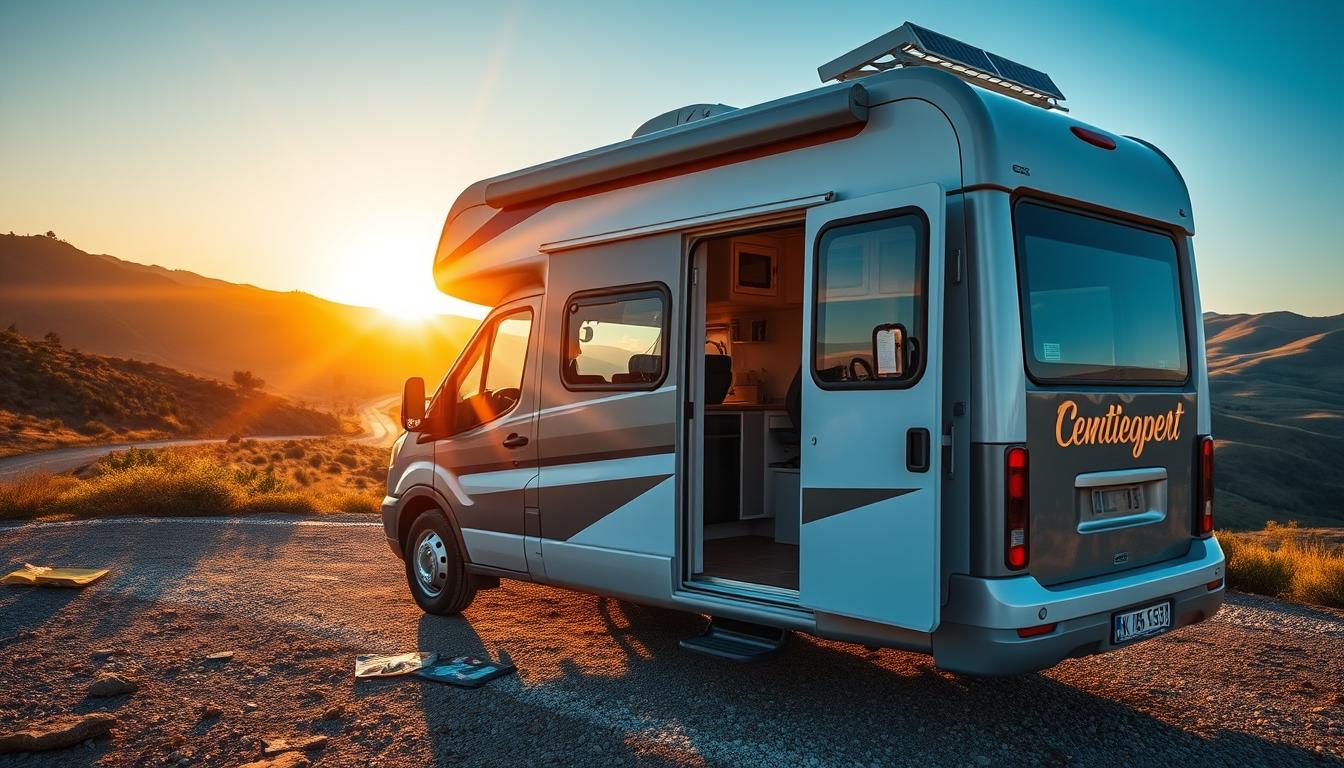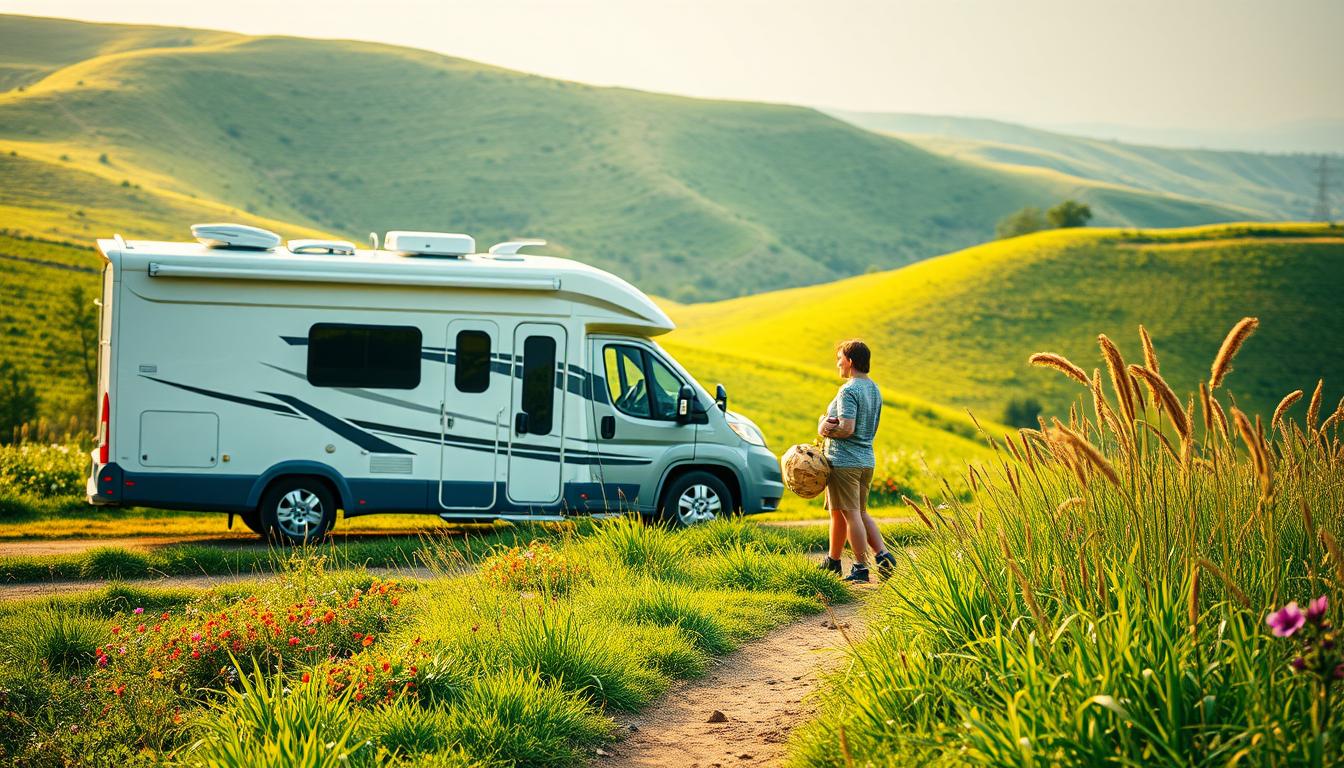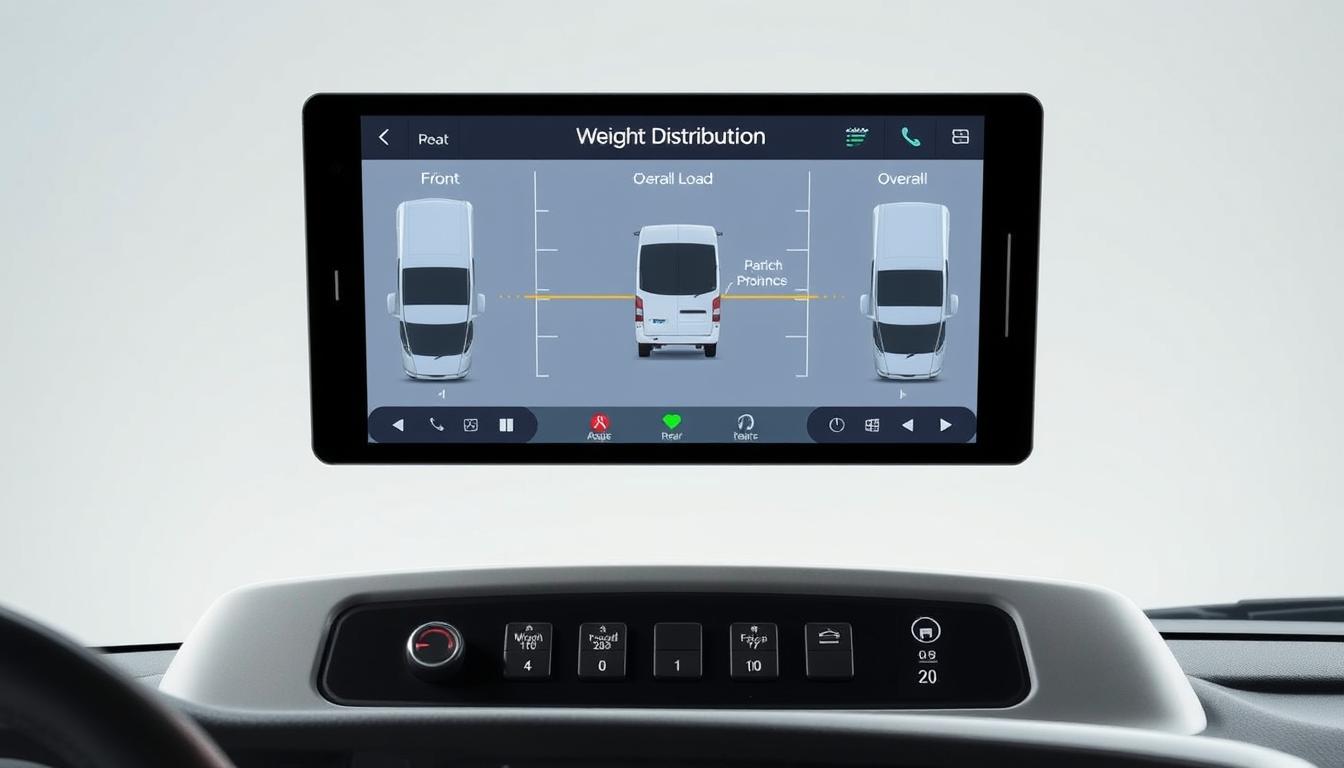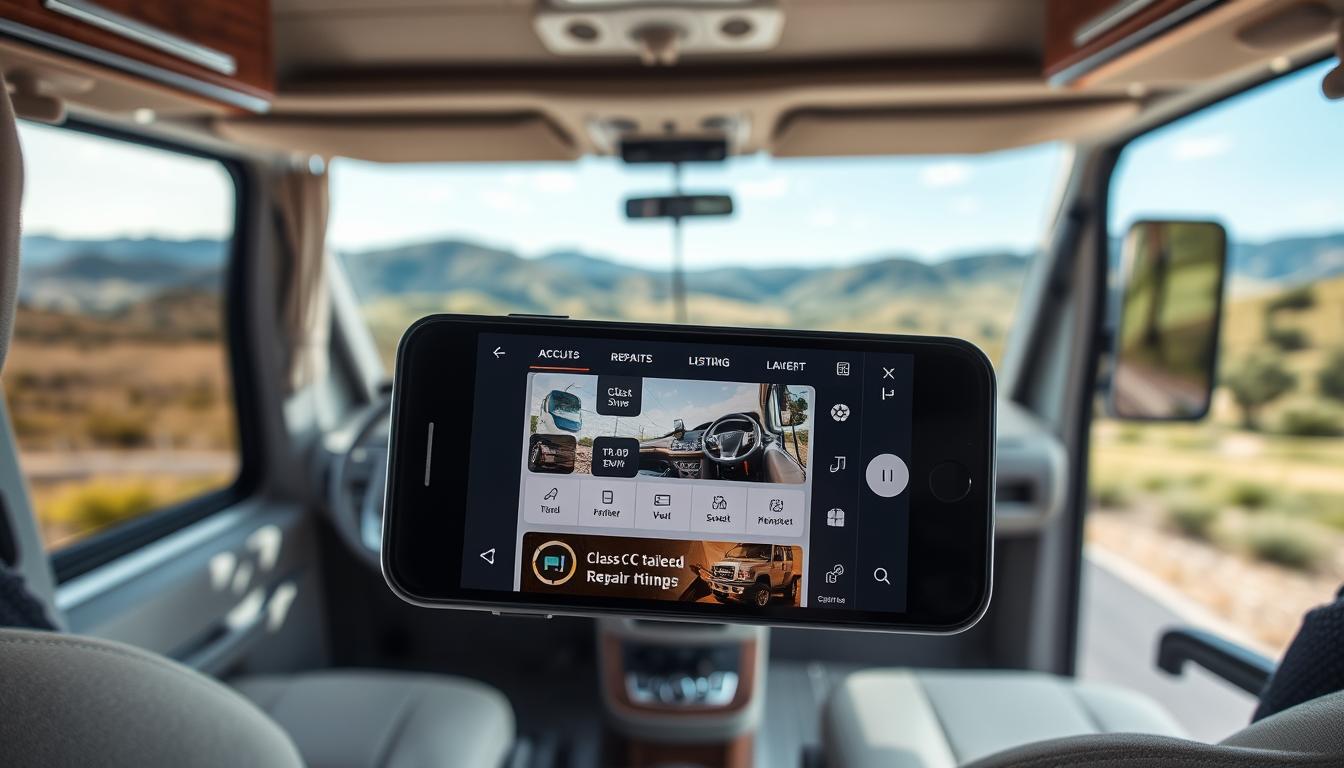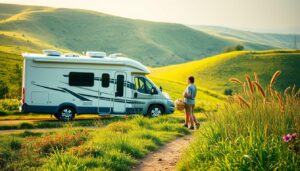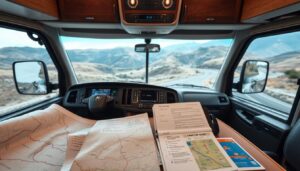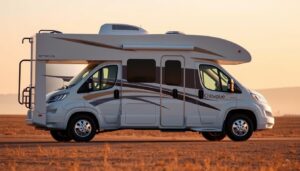Complete guide to prepping your Class C motorhome for long-term journeys
Ever thought about what makes a long RV trip great in your Class C motorhome? It’s not just about packing. It’s about making sure you’re comfortable, safe, and eco-friendly on the road. This guide is packed with tips for both new and experienced RV travelers.
We’ll cover everything from keeping your motorhome in top shape to planning the best routes. Our goal is to help you make your trips unforgettable. Are you ready to learn how to travel long-term in your RV?
Understanding the Class C Motorhome
Class C motorhomes are great for families and travelers. They offer a good mix of space and easy handling. Their cab-over design improves aerodynamics and adds sleeping space.
These RVs are small, making them perfect for both new and experienced RV users. They’re built on standard truck chassis, which makes driving and parking easier. You can find different layouts to fit your needs, from small to large groups.
Class C motorhomes have more storage than Class B models. They have extra rooms and slide-outs for more space. This makes them ideal for families or groups who want to travel together comfortably.
Class C motorhomes come in many styles and features. You can find simple models or ones with the latest tech and fancy interiors. This variety helps you find a motorhome that suits your travel style and budget.
Advantages of Long-Term RV Travel
Long-term RV travel is great for adventurers and families. It lets you travel freely and explore different places at your own speed. You can see amazing landscapes, vibrant cultures, and hidden spots that you might miss on a regular vacation.
Living in an RV helps you connect with nature and local communities. You can camp near beautiful national parks or calm lakes. This can lead to amazing memories, like peaceful hikes, stunning sunsets, or fun times around a campfire.
RV travel also reduces stress from moving often. You can stay in one place for a while before moving to the next adventure. This lets you really get to know a place, find your favorite spots, and enjoy local events.
Being able to change plans easily is a big plus. It can lead to unexpected fun, like meeting new people or going on a surprise trip. RV travel lets you create your own story, making life on the road rewarding and exciting.
Essential Preparations Before Hitting the Road
Before you start your Class C motorhome adventure, making sure everything is ready is key. A detailed pre-trip checklist helps avoid missing important items. It ensures a smooth start to your journey.
First, check your RV’s condition. Make sure tires are good, fluids are at the right levels, and all systems work well. This helps make your trip more enjoyable.
Health and safety are also crucial. Pack all needed medicines and keep health records handy. Check your insurance to see if it covers your travel. If you have pets, plan for their comfort and safety too.
Travel planning is important too. Create a flexible but practical itinerary. Plan stops, sightseeing, and a daily schedule to avoid stress. This way, you can enjoy your RV trip without worries.
Creating a Packing List for Long Journeys
Getting ready for a long trip in your Class C motorhome needs careful planning. A detailed packing list is key to ensure you have everything you need. This makes your journey fun and worry-free. Think about the different types of items you’ll need, like must-haves and comfort items.
Mandatory Items to Consider
Start your RV packing list with must-have items for any long trip. You’ll need your driver’s license, registration, and insurance to travel smoothly. Also, have an emergency kit ready with first aid, basic tools, and flares for unexpected situations.
- Essential documents (license, insurance, registration)
- Emergency kit (first aid supplies, flares)
- Food and cooking supplies (non-perishable food, cookware)
- Personal items (clothing, hygiene products)
Comfort and Convenience Items
Adding comfort and convenience items makes your trip even better. Think about packing bedding, entertainment, and kitchen gear. Comfortable pillows, blankets, and portable electronics can make your journey more enjoyable. Choose camping gear that’s space-saving but still comfy.
- Bedding (pillows, blankets, sheets)
- Entertainment options (books, games, portable devices)
- Kitchen gear (utensils, storage containers)
Maintenance Check for Your Class C Motorhome
Keeping your Class C motorhome in top shape is crucial for long trips. Regular maintenance checks boost safety and extend the life of your RV’s systems. It’s important to stay ahead with routine checks and care.
Regular Maintenance Tasks
Don’t skip routine maintenance tasks. Regular checks can spot problems early. Key tasks include:
- Engine Check: Check oil, coolant, and belts and hoses for damage.
- Tire Inspection: Keep tires inflated and check tread to avoid blowouts.
- Brake System Evaluation: Check brake pads and fluid levels often.
- Electrical System Review: Inspect battery connections and test lights.
Checking Essential Systems
Checking your RV’s main systems is also vital. This includes:
- Plumbing: Look for leaks, check water lines, and test the water heater.
- Heating and Cooling: Make sure the HVAC works well for comfort.
- Propane System: Check for leaks and ensure it’s working right.
By doing these checks, you’re ready for adventures and avoid unexpected problems on the road.
Guides to Adapt Class C Motorhome for Long-Term Travel
Getting your Class C motorhome ready for long trips means making some key changes. First, think about adding more storage. You can install shelves, cabinets, and even storage under the bed. This keeps your space tidy and clutter-free.
Next, upgrade your appliances to make life easier on the road. Choose energy-saving models that use less power. Also, pick compact kitchen tools that save space and make cooking simpler.
Don’t forget to improve insulation. A well-insulated motorhome stays cozy in cold weather and cool in the summer. This makes your travels more comfortable and helps save energy.
Finally, focus on making your motorhome more functional. Add comfy seating, a sturdy dining table, and good lighting. These changes will make your travels more enjoyable and relaxing.
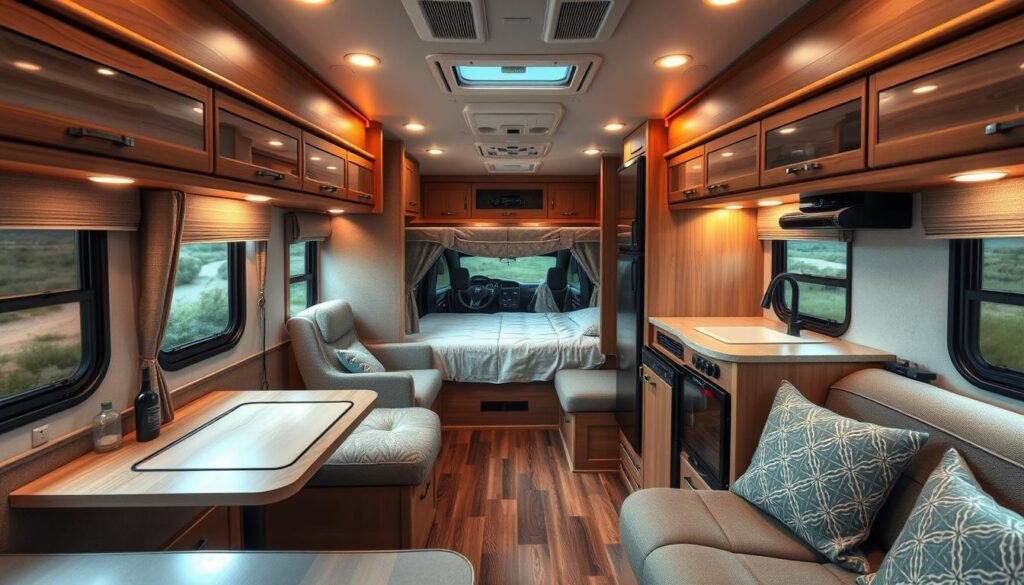
Choosing the Right Route for Your Journey
Planning your RV journey is key to a great trip. You need to think about many things that can change your experience. The condition of the roads is very important. Smooth roads make your trip more comfortable.
Height and weight limits are also crucial. Some roads and bridges have rules that might slow you down. Always check these before you leave. Apps like advanced RV navigation tools can help a lot.
Don’t forget to include fun stops on your route. Parks, attractions, and unique places make your trip special. Adding these to your plans means you’ll have great memories and breaks from driving.
Being flexible is important when traveling in an RV. While planning is important, being open to changes can lead to new discoveries. Watch the weather and road conditions to adjust your plans if needed. Exploring different routes can uncover hidden treasures.
In short, good RV route planning is about more than just getting from point A to point B. It’s about enjoying the journey. With the right mindset, RV travel can be incredibly rewarding.
Setting Up Camp: Campsite Selection and Reservations
Choosing the right campsite is key to enjoying your RV trip. Booking your campsite early ensures you get the best spots. Look into different RV campgrounds to find the perfect mix of comfort and nature.
Researching Campsites Ahead of Time
Looking into campsites before you go can avoid last-minute headaches. Focus on places with the basics like electricity and water. Use online reviews and local guides to find the best fit for you.
DIY vs. Campground Facilities
Think about what you want from your camping experience. Campgrounds offer comforts like showers, while DIY sites provide a raw adventure. Choose what suits your style best.
| Feature | RV Campground Options | DIY Campsites |
|---|---|---|
| Amenities | Electricity, water, restrooms | Basic and limited amenities |
| Cost | Higher fees | Generally lower fees |
| Setup Time | Usually easier | May require more effort |
| Social Environment | More social interaction | Often quieter and more isolated |
Stay open to changes as you travel. You might find great campsites you hadn’t thought of. Being flexible can lead to amazing experiences on the road.
Handling Water, Waste, and Propane Needs
Managing water well is key for a great RV trip. Start by saving water by taking shorter showers and using water-saving devices. Keep an eye on your tank levels to avoid surprises and refill or dispose of waste on time.
Knowing how to handle waste is also important. Many places have special spots for waste disposal. Knowing where these are helps keep things clean and follows the rules. Always have the right tools, like sanitation hoses, for safe disposal.
Propane management is also crucial for a comfy trip. Check your propane often to ensure you have enough for heating and cooking. A good gauge helps you avoid running out when you need it most. Having an extra tank can give you peace of mind on long trips.
Remember, safety is always first when dealing with water, waste, and propane. Good management makes your trip more comfortable and helps the environment.
Daily Life on the Road: Balancing Routine and Adventure
Living in an RV is a mix of freedom and duty. It’s all about finding a balance between fun adventures and daily tasks. Learning to manage your time well is key. This helps you plan trips, cook meals, and relax.
Time Management in an RV
Good time management makes traveling easier. Having a flexible plan helps you stay on track but also leaves room for surprises. Use time-blocking to organize your day. Set aside time for fun, exploring, and chores.
Minimizing Stress During Travel
Staying calm on the road takes preparation and being flexible. Talking openly with your travel buddies helps everyone feel heard. Also, going with the flow can make your trip more enjoyable. Don’t be afraid to stop and explore new places.
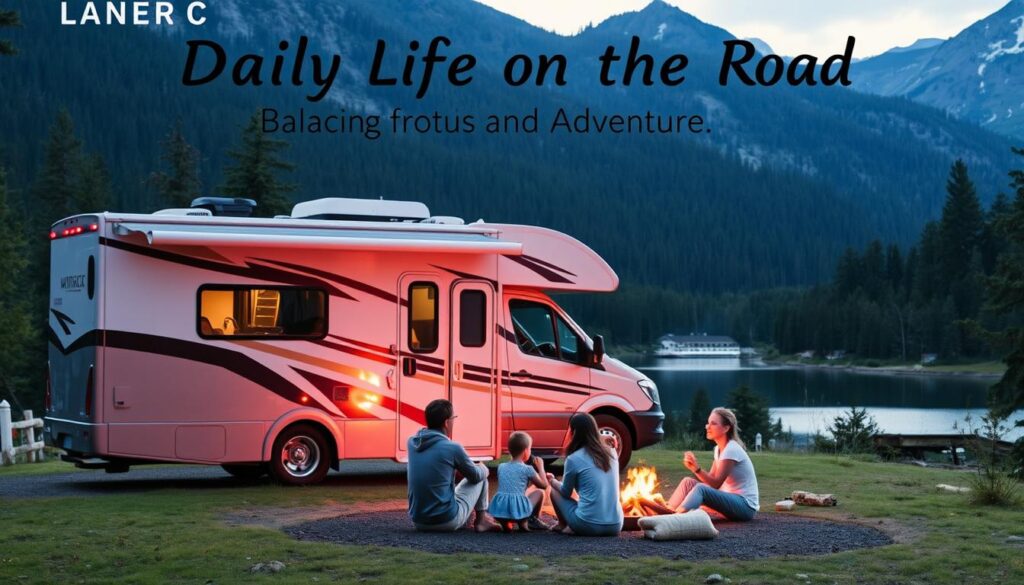
Safety Tips for Long-Term Travelling
Keeping safe on long trips is key for a great RV adventure. Before you leave, do a full check-up on your RV. Look at engine fluids, tire pressure, brakes, and lights. Each part is important for your safety on the road.
Having the right safety gear in your RV is smart. This includes fire extinguishers, first-aid kits, and emergency flares. Make sure you can get to them quickly. Following road safety rules helps avoid accidents.
Knowing the local laws is crucial. Speed limits, RV parking, and camping rules change by place. Knowing these laws helps you stay safe and respect others.
Keeping your stuff safe in your RV is important. Use lockable spots and safe places when camping. Also, be aware of your surroundings and follow safety rules to protect yourself and others.
Weather can change fast on the road. Always check the forecast and be ready for changes. By focusing on RV safety, your long trip will be fun and safe.
Emergency Preparedness in Your Motorhome
RV emergency preparedness is key for long trips in a Class C motorhome. Being ready for the unexpected can greatly improve your journey. A good roadside safety kit and solid travel plans can help you relax on the road.
Creating an Emergency Kit
Your emergency kit should have items for different situations. First-aid supplies like bandages and antiseptic wipes are a must. Don’t forget tools like screwdrivers and pliers for small fixes.
Communication tools are also crucial. A portable charger or satellite phone can be lifesavers in emergencies. Adding water purification tablets and non-perishable food can also be smart. Make sure your kit is ready and easy to find to save time in a crisis.
Plan for Unexpected Situations
Having travel plans for unexpected events is vital. Look up your route to find safe places for help and to stay overnight. Keep a list of service centers and hospitals nearby. A well-stocked roadside kit is essential for any road challenge.
Using resources to make your emergency kit can make prep easier. Apps like first-aid apps can help manage your supplies. Being prepared ensures a smooth trip in your Class C motorhome.
Conclusion
As we finish this guide on getting ready for long trips in a Class C motorhome, let’s think about the main points. These points will make your RV travel fun and meaningful. Planning well is key, from knowing your motorhome’s needs to packing right and keeping it in good shape.
Every step you take in preparing helps. It makes your journey more comfortable and exciting. You’ll be ready for adventure and enjoy the ride.
Traveling comes with its ups and downs, but being open to new things can make it special. Use the tips from this guide to handle any problems that come up. From picking the best campsite to keeping your motorhome running smoothly, every choice makes your trip better.
Exploring new places in a Class C motorhome is exciting. With the right preparation, you’ll be ready for an amazing adventure. So, get ready, set your path, and enjoy the journey. The road is waiting for you!
FAQ
What are the main features of a Class C motorhome?
Class C motorhomes have a unique design with the cab over the living area. This design saves space and improves aerodynamics. They are great for families because they are easy to maneuver and have lots of storage.
What should I include in my long-term RV packing list?
Pack essential documents and emergency kits for long trips. Don’t forget food, cooking supplies, bedding, and personal items. Add comfort items like entertainment and kitchen gear. Remember to pack smart to save space in your RV.
How do I ensure my Class C motorhome is ready for long-distance travel?
Check your RV’s engine, tires, brakes, and electrical systems before you go. Make sure plumbing, heating, and cooling are working well. Follow the manufacturer’s maintenance schedule to keep everything in top shape.
What are some key considerations when selecting travel routes?
Look at road conditions and RV size restrictions when choosing routes. Use RV apps to find safe and efficient paths. This helps avoid unexpected problems on your trip.
What should I know about campsite selection and reservations?
Find campsites with amenities like hookups for RVs. Choose between rustic spots and RV parks. Book early to secure your spot, but stay open to changes for better experiences.
How can I effectively manage water, waste, and propane needs?
Save water and check tank levels often. Use RV waste stations wisely. Keep an eye on propane for heating and cooking.
What daily routines should I establish while living in an RV?
Plan meals, activities, and downtime in your RV. Good time management is key. Communicate well with travel buddies to enjoy your trip more.
What are essential safety tips for RV travel?
Do pre-trip checks and ensure safety gear works. Know the weather and local laws. Keep valuables safe and stay cautious while camping.
What should be included in an emergency kit for RV travel?
Your kit should have first-aid, tools, and communication devices. Plan for breakdowns or bad weather. This ensures safety and readiness on long trips.
